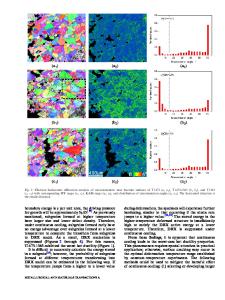Fracture behavior of stainless steel-toughened NiAl composite plate
- PDF / 2,848,424 Bytes
- 10 Pages / 630 x 792 pts Page_size
- 78 Downloads / 262 Views
I.
INTRODUCTION
A L T H O U G H intermetallics have been the subject of substantial research because of their inherent high specific stiffness, high melting points providing the potential for high-temperature strength, and oxidation resistance, their transition to applications has been severely limited because of poor room-temperature ductility and toughness. While some progress has been made in ductilizing a limited number of interrnetallics, the vast majority of intermetallics continue to suffer from low toughness. The object of the current research effort is to toughen intermetallics by incorporating conventional ductile metals to result in a hybrid material that possesses substantially improved toughness relative to the baseline intermetallic. The incorporation of the ductile metals into the intermetallic is done such that the ductile regions are present as continuous regions extending along the length of the composite. The primary benefit of the above approach is that it is generic in nature and can be applied to virtually any intermetallic through appropriate choice of the ductile toughening region. The system investigated in the current work is a model composite system consisting of the intermetallic NiA1 containing boron carbide particulate (B4C) as a secondphase addition and 304 stainless steel as the ductile metal toughening regions. The intermetallic NiA1 was selected because it displays good formability at elevated temperature, but attempts to toughen NiA1 through alloying or thermomechanical processing have met with limited success. The B4C particulate was added primarily as a den= sity reducing agent, and no attempt was made to assess its effect on the mechanical behavior of NiA1. The 304 stainless steel was selected as the model toughening region because of its inherent high toughness, a hot workVINCENT C. NARDONE, Senior Research Scientist, is with United Technologies Research Center, East Hartford, CT 06108. Manuscript submitted March 26, 1991. METALLURGICAL
TRANSACTIONS A
ing temperature regime similar to that of NiAI, and availability. Note that if a system were being designed for elevated temperature strength, alloyed NiA1 with superalloy toughening regions could be considered. Documentation of the tensile and impact behavior B4C / NiA1 with 304 stainless steel tubular regions has recently been demonstrated, where the composites were produced in the form of circular extruded rod. il,2J The term microstructurally toughened composites (MTC*) was *MTC is a registered trademark of United Technologies Corporation, Hartford, CT.
utilized to describe these materials, as both the microstructural interfacial regions as well as the overall macrostructural constituent arrangement were found to have an effect on the energy absorption levels in the composites. The current work was aimed at producing NiA1 base MTC in the form of rectangular extruded plate. The production of plate material allowed determination of tensile and impact properties of the composite as a function of orientation. In addition, fr
Data Loading...











